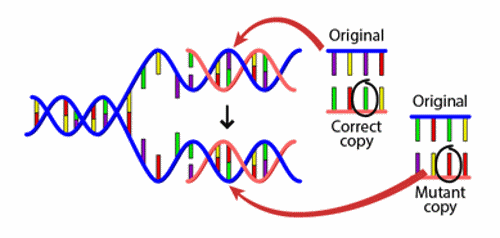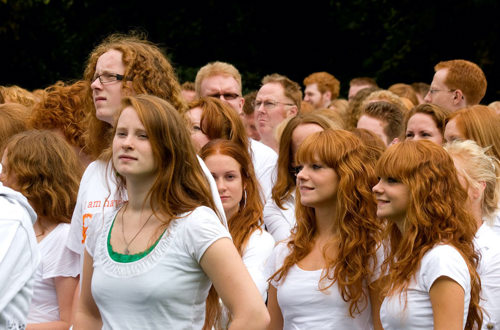
Did red hair in humans come from interbreeding with Neanderthals?
October 14, 2009

- Related Topics:
- Red hair,
- Hair color,
- Neanderthals,
- Pigmentation traits,
- Appearance,
- Genetic myths,
- Complex traits
A curious adult from California asks:
"I read on the web that some people think that red hair is a sign that humans and Neanderthals interbred because red hair came from the Neanderthals. Is this true?"
Back in 2001, some researchers speculated that the "red hair" gene of Europeans came in too many varieties to have come from human stock. They reasoned that it must have come from somewhere else. The most likely candidate was the folks living in Europe when humans got there -- the Neanderthals.
Since then, most of the evidence has not supported humans and Neanderthals regularly having babies together. Most likely, we were fighters and not lovers and wiped the poor species out. What this all means is that Europeans probably aren't Neanderthal-human hybrids.
Scientists did recently show that at least some Neanderthals had red hair. But this turned out to be evidence against interbreeding. Why? Because Neanderthals end up with red hair in a way not yet seen in people.
Now I don't mean they had red hair because they used a different gene than Europeans do. Both Neanderthals and Europeans use the same gene to get red hair -- MC1R. The difference is that they both use the gene a bit differently.
So for right now it looks like humans got their red hair from their own genes. But keep in mind that scientists haven't looked at the DNA from a lot of different Neanderthals yet.
It might be that Neanderthals had lots of ways to end up with red hair and we happened to find one way that we don't share. If scientists do find some human versions of the MC1R gene in Neanderthals, then that would support the idea that the two interbred.
(Although remember this would just be one piece of evidence against a whole lot of evidence against interbreeding.)
I thought what I'd do next is go into a bit more detail about all of this. Even though it looks like red hair didn't come from Neanderthals, we still don't have a good explanation for why there are so many different versions of the MC1R gene in Europeans.
MC1R and Red Hair
As I said before, red hair happens because of the MC1R gene. Well, it actually happens when this gene can't do its job quite right.
See, each gene is really just the recipe for a specific protein. And each protein has a specific role in the cell.
The MC1R gene has the instructions for making the MC1R protein. And one role of this protein is to get rid of the pigment that gives red hair, pheomelanin.
Some people have versions of the gene that can't do this job very well. The end result is that they get a build up of red pigment and have red hair.
Now this isn't what made people think that red hair came from Neanderthals. For example, blue eyes (and most every other trait) happen in the same way and no one is claiming that we inherited blue eyes from Neanderthals.
What makes red hair different is that there are so many different versions of the MC1R gene. And that there has been so little time for them to happen.

Gene Changes and Time
As humans, we all share nearly the exact set of genes. What makes us each different is we have different versions of these same genes.
For example, some people have red hair versions of the MC1R gene and have red hair. Other people have different MC1R gene versions and don't have red hair.
The same sort of thing goes for eye color and the HERC2 gene. Or skin color and the SLC24A5 gene. Or most any other trait you can think of and its associated gene(s).
All of these different gene versions are there because of DNA changes that happened at some point in our history. People tend to think of DNA as stable and written in stone and for the most part it is. But even stones can get chips once in a while.
DNA can and does change over time. But very slowly. And it seems like humans were in Europe for too short a time for there to be so many different versions of the MC1R gene.
Out of Africa
The evidence so far supports the idea that all humans started out in Africa. Around 40,000 years ago, a small group arrived in Europe. These original settlers almost certainly looked more like modern Africans than modern Europeans.
Modern Africans are by far the most genetically diverse group on Earth. Except when it comes to most skin, hair, and eye color genes. These genes are very similar within the population (to protect them from the sun).
Remember, this is the group that settled Europe 40,000 years ago. And the situation is very different there now. Europeans have the widest range of skin, hair, and eye color of any group on Earth. So where did that diversity come from?
One possibility is that there were a few Africans who already had these changes and when the conditions were right, these gene versions became common. The other possibility is that these DNA changes happened in the last 40,000 years.
Traits like lighter skin and different eye colors could have happened either way. A single difference in a single gene explains a good part of the skin color difference between Africans and Europeans. Same thing with lighter colored eyes.
But red hair is different. So far over 80 different versions of the MC1R gene have been found in Europeans. And this gene is one of the least diverse in Africans (because of the light skin that happens when the gene isn't working). This is an awful lot of change for 40,000 years.
This is why some people thought that red hair must have come from Neanderthals. The idea was that Neanderthals didn't need protection from Europe's weak sunlight and so the MC1R gene was free to build up DNA changes over the hundreds of thousands of years they lived there.

Why the Variety?
The consensus right now is that Europeans are not a mix of Neanderthals and humans. Of course with more evidence that could change. As scientists figure out Neanderthal MC1R genes from many different individuals, they may find that we did interbreed.
But if we didn't, then why the wide variety in the MC1R gene in Europeans? There are lots of possibilities but I'll just discuss one.
It could be that the MC1R gene happens to be a place in our DNA that changes a lot. There are "hotspots" like this scattered throughout our DNA.
The reason it didn't show up in Africans is that light skin was such a disadvantage that anyone who had it did not do very well at all. They ended up sunburned, with skin cancer and, maybe even with babies that had numerous birth defects.
There isn't any evidence yet to support this idea. But scientists will keep looking at the MC1R gene to try to figure out why it is so diverse in Europeans. Maybe my great, great, great (...) grandpa was a Neanderthal after all.

Author: Dr. Barry Starr
Barry served as The Tech Geneticist from 2002-2018. He founded Ask-a-Geneticist, answered thousands of questions submitted by people from all around the world, and oversaw and edited all articles published during his tenure. AAG is part of the Stanford at The Tech program, which brings Stanford scientists to The Tech to answer questions for this site, as well as to run science activities with visitors at The Tech Interactive in downtown San Jose.
 Skip Navigation
Skip Navigation
